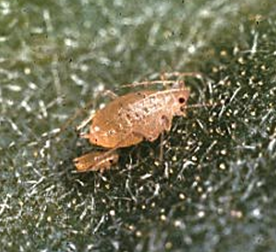
Karen Delahaut, formerly UW-Madison Fresh Market Vegetable Program
Revised: 4/26/2004
Item number: XHT1127
Whiteflies are not true flies although they look fly-like. They actually belong to the same order of insects as scales, aphids, and mealybugs: the order Homoptera. There are several species of whiteflies that can infest greenhouses including the greenhouse (Trialeurodes vaporariorum), sweet potato (Bemisia tabaci), silverleaf (Bemisia argentifolia), and bandwing (Trialeurodes abutilonea) whiteflies. Of these, the greenhouse whitefly is the most common in northern areas. The silverleaf whitefly is responsible for causing phytotoxemia in poinsettia as this species extracts more sap than the other species. Bandwing whiteflies can enter the greenhouse in late summer or early fall but are not as much of a problem as previously mentioned species. Host plants include fuchsia, geranium, hibiscus, gerbera daisy, and poinsettia. Vegetable hosts include cucumbers, tomatoes and eggplant.
Appearance: Whitefly adults resemble tiny moths and are covered with a whitish powder. Species identification can be made by examining the wing markings. The first instar nymphs resemble scales, but they become a transparent yellow-green and settle once they reach the second and third instar stages.
Symptoms and Effects: Like all other Homopteran insects, whiteflies have piercing-sucking mouthparts and feed on plant juices. Damage consists of yellowing and wilting of the foliage. In severe cases, plant death may occur. Whitefly infestations in vegetable crops will produce a noticeable yield reduction. Honeydew and sooty mold may also be present if populations are large enough. Whiteflies are capable of transmitting viruses to some hosts, but at the present time, this is not a major concern.
Life Cycle: Female whiteflies lay six to 20 eggs per day on the lower leaf surface of host plants. The eggs are white initially, but become dark brown as they mature. Eggs hatch in seven to 10 days and the mobile, first instar crawlers resemble scales. Within several hours of hatching, these crawlers will seek out a suitable place to settle, where they will pass the next two instars. The final instar is often referred to as a pupa although the whiteflies go through simple metamorphosis in which a true pupal stage is absent. There can be several generations of whiteflies per year, with each generation taking one to three months to develop depending on the temperature of their environment. At 82°F, whiteflies develop from egg to adult in 18 days.
Scouting Suggestions: Check hanging baskets frequently and monitor any weeds that may be growing beneath greenhouse benches. Begin monitoring susceptible crops such as fuchsia and poinsettia at planting. Yellow sticky traps placed just above the crop canopy will help you monitor adult whiteflies, as will a gentle shaking of the foliage. A more thorough visual inspection of the foliage is necessary to detect whether immature nymphs are present. Placing trap crops such as fuchsia near doors and air-intake vents can signal when whiteflies are moving into the greenhouse.
Control:
Non-Chemical: There are no established treatment thresholds, but plants can handle more whiteflies than greenhouse managers can tolerate. Typically a mature poinsettia plant can tolerate up to 50 whiteflies per leaf before damage occurs.
Good sanitation and exclusion are critical for whitefly management. Eliminate all plants including weeds and “pet” plants for at least one week before starting a new crop. Inspect all new plant shipments. Screen vents to keep bandwing whiteflies from entering the greenhouse in the fall. Avoid excessive fertilization and irrigation.
There are several parasitic wasps that control whiteflies. The most common is Encarsia formosa which is commercially available. Other available natural enemies are Encarsia luteola, Eretmocerus eremicus, Chrysoperla comanche, Chrysoperla rufilabris, Delphastus pusillus, and several minute pirate bugs (Orius spp.).
For additional information on biological control, refer to NCR publication 581, Biological Control of Insects and Other Pests of Greenhouse Crops.
Chemical: There are several insecticides available for control of whiteflies. Whitefly management is difficult without pesticide use. It is critical that you rotate chemical classes to prevent an outbreak of insecticide-resistant populations. Start any chemical control program early and treat every five to seven days for a total of three treatments to control all stages of overlapping generations. Watch closely and evaluate for the development of resistant whitefly populations. If you find you aren’t getting suitable control with one class of insecticide, switch to another.
Download Article





 Biological Control of Insects and Mites: An Introduction to Beneficial Natural Enemies and Their Use in Pest Management
Biological Control of Insects and Mites: An Introduction to Beneficial Natural Enemies and Their Use in Pest Management Managing Thrips in Greenhouses
Managing Thrips in Greenhouses Managing Aphids in Greenhouses
Managing Aphids in Greenhouses Scales
Scales


